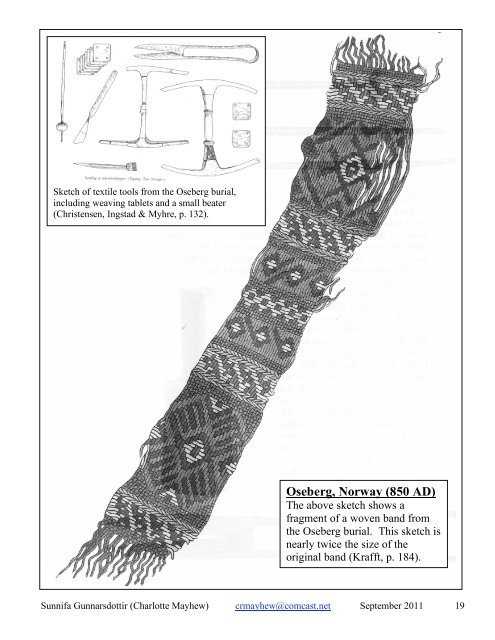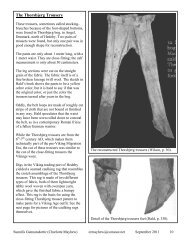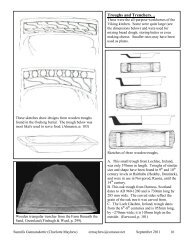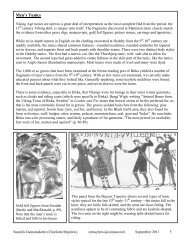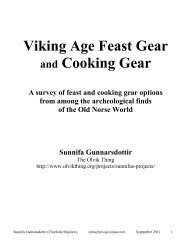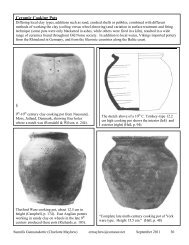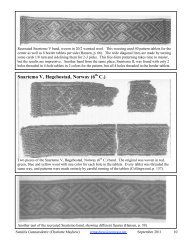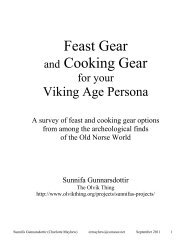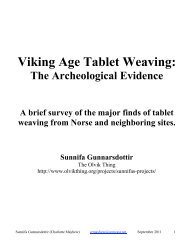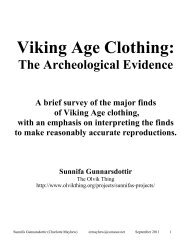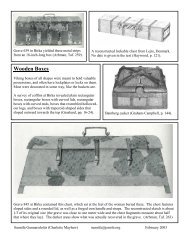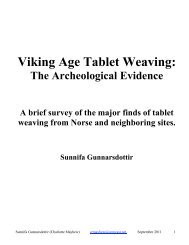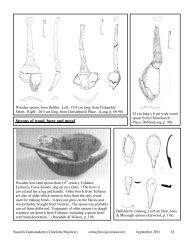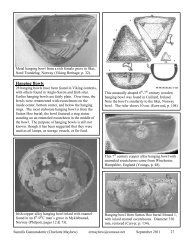Viking Age Tablet Weaving Class Handout pgs 19-24 ... - Olvik Thing
Viking Age Tablet Weaving Class Handout pgs 19-24 ... - Olvik Thing
Viking Age Tablet Weaving Class Handout pgs 19-24 ... - Olvik Thing
- No tags were found...
You also want an ePaper? Increase the reach of your titles
YUMPU automatically turns print PDFs into web optimized ePapers that Google loves.
Sketch of textile tools from the Oseberg burial,including weaving tablets and a small beater(Christensen, Ingstad & Myhre, p. 132).Oseberg, Norway (850 AD)The above sketch shows afragment of a woven band fromthe Oseberg burial. This sketch isnearly twice the size of theoriginal band (Krafft, p. 184).Sunnifa Gunnarsdottir (Charlotte Mayhew) crmayhew@comcast.net September 2011 <strong>19</strong>
Cingulum of Bishop Witgarius, Augsberg, Germany (860-876 AD)This type of weaving was done with the cards turning 1/8 turn each time, which allows more brocadingthread to lay on the top surface of the weaving, thus giving the weaving more luster. In addition, thismethod is easier on the brocading thread, as it doesn’t bend so much (Collingwood, p. <strong>24</strong>2-<strong>24</strong>3).Sketch of the girdle of St. Witgarius (Spies, p. 87).Close-up of reverse of band (Collingwood, p. <strong>24</strong>4).The weft brocading was done with goldwrappedsilk thread on the girdle of St.Witgarius, S. Germany (860-876AD). Notethe heraldic eagles (Collingwood, p. <strong>24</strong>3).Sunnifa Gunnarsdottir (Charlotte Mayhew) crmayhew@comcast.net September 2011 21
Maniple of St. Ulrich,Augsburg, Germany (10 th C.)Above is a photo of one end of the manipleof St. Ulrich. The main body of themaniple is worked in double-faced 3/1broken twill and features patterns that arevery similar to those found in Norse sites.The Hand of God motif and wordsDEXTRA DEI were woven in a doublefacedweave on a warp-twined background,most of which is hidden by the goldbrocading (Collingwood, p. 210).Reproduction of the maniple of St. Ulrich. Note thepatterns in the middle of the stole (Spies, p. 237).Sunnifa Gunnarsdottir (Charlotte Mayhew) crmayhew@comcast.net September 2011 22
Speyer Cathedral,Germany (9 th /10 th C.)Photo of a red and white silk bandfrom Speyer Cathedral which waswoven in plain weave(Collingwood, p. 150).The above is the border of a cingulum from SpeyerCathedral which had a white silk brocade weft(represented by black dots) on a red silk background(the white squares) and a red silk weft thread. Thetablets were all Z-threaded in the center, but the bordertablets were threaded S and Z alternatively. There werea total of 96 tablets (60 in the center and 18 in eachborder). In the center of the band were words worked inturning patterns that were very subtle (Spies, p. 147).Sunnifa Gunnarsdottir (Charlotte Mayhew) crmayhew@comcast.net September 2011 23
The band from the Iron <strong>Age</strong> Lonne Hede skirt was 6cm wide and ran the length of the skirt. The replicawas woven with 58 two-threaded and 4 four-threaded tablets in 20/2 worsted wool (Hansen, p. 65).Lonne Hede, Denmark (Iron <strong>Age</strong>)Band & Durham, UnitedKingdom (12 th -13 th C.) Seal Tag:2 repp-effect double-faced bandsRogers, p. 91<strong>Tablet</strong> woven bands attached to a 12 th -13 th C. document show patterning similar to a band from DoverBuckland in the 6 th C. This band is from Durham Cathedral (Rogers, p. <strong>24</strong>8). See close-up above.Sunnifa Gunnarsdottir (Charlotte Mayhew) crmayhew@comcast.net September 2011 <strong>24</strong>


